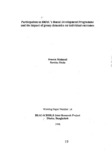Participation in BRAC's Rural Development Programme and the impact of group dynamics on individual outcomes
Citation
Mahmud, S., & Huda, S. (1998). Participation in BRAC’s Rural Development Programme and the impact of group dynamics on individual outcomes. Research Reports (1997): Economic Studies, Vol - XII, 37–66.Abstract
This study explored women's participation in Brae's rural development programme to
identify some unobserved selecting factors that are believed to influence women's
decision to participate or not and, the effect of group dynamics on individual outcomes
of women programme participants. The data used for the study originates from Brac-ICDDR,
B Joint research project in Matlab (April-Aug. '95). Ever married women aged
between 15-50 years in 2,241 households of 14 villages with Brae interventions were
included in the study. The results show that women's decision to participate was
determined significantly by reported health status, perceived contribution to
household income, household land ownership, relation with husband and unwanted
pregnancy. The individual factors like age, literacy, marital status, etc. had no effect on
the decision to participate. Group dynamics was captured by three indexes e.g., VO
(village organization) homogeneity, VO activity and VO social awareness. Of these, VO
homogeneity appeared to have the most consistent and positive effects on mobility, ·
income-earning and modern family planning use. There were cross-cutting effects of the
other two indexes on outcomes. From the findings, it is desirable to pay greater
attention to group mobilisation and group formation processes in programme
implementation.

